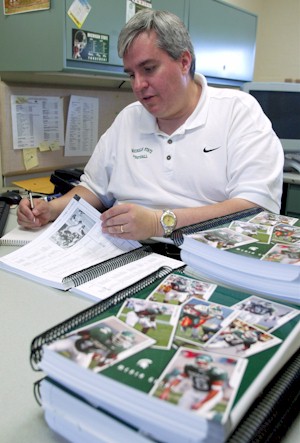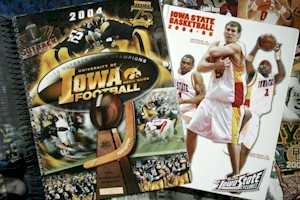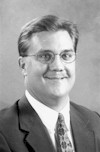|
Fat media guides go on crash diet
 |
| The University of Missouri's
614-page 2004 football media guide pictured in this June 1, 2005,
photo in Columbia, Mo., is unofficially the largest in the nation.
Starting this coming school year all media guides will have a
maximum of 208 pages. |
|
(AP Photo/L.G.
Patterson) |
| |
 |
| Running back Ken Strayhorn (43) was
the star attraction on the cover of the 1975 East Carolina football
media guide. The book's modest digest size and black and white
content pale in comparison to the current era's lush color-filled
volumes. |
|
(Bonesville.net
Digital Image Archives) |
| |
 |
| Michigan State associate athletic
director John Lewandowski looks over media guides Thursday, May 12,
2005, in East Lansing, Mich. Michigan State will need to cut 92
pages from its media guide to follow a new NCAA rule that colleges
trim their media guides to 208 pages for the next school year. |
|
(AP Photo/Al Goldis) |
| |
 |
| A University of Iowa football media
guide, left, and an Iowa State University basketball media guide,
right, are shown, Monday, June 6, 2005, in Des Moines, Iowa.
Athletic department staffers at Iowa and Iowa State are trying to
figure out what to cut and what to keep to bring their guides into
compliance with a new NCAA rule that limits their size. |
|
(AP Photo/Charlie
Neibergall) |
| |
|
|
|
|
|
|
|
|
|
From staff and wire
reports
©2005 Bonesville.net
In the rough and tumble
Big 12, affluent Missouri is always looking for a deluxe edge to impress
recruits, while in an upwardly-mobile league like Conference USA, East Carolina
is after the same objective but with an eye on the bottom line.
The Tigers thought they
had found a powerful solution with a mammoth 614-page football media
guide — unofficially, the largest in the nation — that is mailed to
prospective student athletes. But the NCAA is taking it away with an
edict that colleges prune their media guides to a maximum of 208 pages
for the upcoming school year.
The new rule has sports
information directors across the country scrambling to decide what will
make the cut when a hundred or more pages in some current guides must be
scrapped. And many of them aren't happy.
``Our football coaching
staff believes putting together a first-class book helps sell the
program,'' said Chad Moller, Missouri's director of media relations for
athletics. ``Now we will have to find other creative ways to make our
book stand out from the crowd.''
Tom McClellan, Director of
Media Relations at East Carolina, notes that the new restraints will
also require his office to trim some fat from its media guide. Unlike
many of his peers, however, he views the change as an economically
sensible step in the right direction.
|
 |
| Unlike some
of his peers at schools like Missouri and
Michigan State, East Carolina Director of
Media Relations Tom McClellan (above) has no
objections to a new NCAA decree that limits
the size of football media guides. (ECU) |
|
|
"While I perhaps stand in
the minority, I simply welcome and endorse the NCAA's attempt to create
a level playing field on this issue," said McClellan in an e-mail
exchange. "With that said, please also understand that East Carolina,
literally, does not have much to lose with the new legislation to start
with."
As for the stance of ECU
coach Skip Holtz on the new restrictions, it's a non-issue, noted
McClellan.
"Skip's only request
regarding the production of the media guide has pertained to the
covers," he said. "He's always been a big believer in rewarding the
seniors by placing them on the front and back for added visibility."
Schools such as Nebraska
and Georgia are faced with the prospect of cutting their football guides
in half before the start of next season. Publications go to print this
summer.
McClellan, who assumed his
position at East Carolina after the school's 2004 guide was designed,
isn't concerned about the 16 pages he will have to sacrifice in the forthcoming
edition.
"The folks at ECU who
produced last year's book, set at 224 pages, incorporated a lot of
'wiggle room' which can be condensed in an attractive manner," he
said.
Men's basketball guides
are the only other publication likely to be media widely affected by the new
regulation, which was adopted last month.
Supporters of the
rule say restricting the size of the guides will save universities
money. It reduces the pressure for lower-income programs to keep up with
college athletics' big spenders by producing glitzy guides.
NCAA spokeswoman Jennifer
Kearns' sentiments are similar to McClellan's.
``It's about leveling the
playing field,'' she said.
The directive also affects
recruiting because the guides often are sent to prospective student
athletes.
``From a recruiting
standpoint, it's more impressive to drop a 20-pound book on the coffee
table than a 6-ounce book,'' said Mike Nemeth, a Mississippi State
associate athletic director. ``This will put everybody in the same
ballpark.''
The Bulldogs last year produced
a football media guide a
little larger than East Carolina's. The size of the 296-page guide was
dictated at least in part by a need to avoid being dwarfed in comparison by larger volumes published by Florida, Tennessee and
other Southeastern Conference rivals.
Many schools devote space in their
media guides to alumni in the pros and draft pick histories, although
it's not clear how much weight — if any — the books have with recruits.
``It's probably way down
the list,'' Nemeth said.
Mississippi State expects
to save a few thousand dollars on printing costs with the smaller
guides, money the department gladly will spend on other projects, Nemeth
said.
For East Carolina, which
has an athletics budget in the range of $18 million, McClellan sees
clear fiscal advantages in downsizing the book, including greater
flexibility in how resources are allocated.
"The most obvious gain
from this new development is a significant savings or at least a
redirection on spending within a departmental budget," McClellan said.
"In my opinion, if it is indeed solely a recruiting piece, there are
many other areas which can benefit from added financial resources to
enhance the process than an extra 300 pages in a media guide."
But the overall cost
savings are minor in relative terms for some of the more lavishly-funded programs.
Michigan State, for example, spent about $60,225 last year designing and
printing its 300-page football media guide. A 208-page guide would cost
about $18,000 less.
The Spartans' overall
athletics budget is about $55 million.
Smaller guides could
result in shorter player profiles, abridged records sections or more
selective lists of letter winners — a slap to team members, Michigan
State associate athletic director John Lewandowski said.
``It's their keepsake, the
record of their careers,'' he said.
The NCAA will allow
schools to distribute some extra information to media members through the
Internet or material printed in black-and-white format. But documenting
records and milestones in such a way could eliminate some of the cost
savings realized through smaller media guides.
McClellan observed that East
Carolina expects to deploy an enhanced
official athletics Web site by late this
summer. He indicated the print publication and Web site together will
offer more, not less information.
"For starters ... we will
be adding all of our media guides on-line in the future," said
McClellan. " ...
If there is something in particular not included in the media guide, it
will be available in our game note packages each week, also available
on-line."
Because of the work of
summer intern Thomas Rosenbaum, noted McClellan, the net sum of
historical information about the Pirates that will be accessible in one
form or another will markedly increase.
Rosenbaum "has researched
ECU football in great detail and compiled an impressive data base of
single-game stat listings for the past 40 years," said McClellan.
East Carolina plans to
release its media guide the last week of July in conjunction with
Conference USA's annual media gathering in Memphis, added McClellan.
The Michigan State guide,
like many others, lists letter winners from football teams throughout
school history. Each season is listed, with game-by-game results dating
back to 1896.
The guide details every
series the Spartans have played, from the 1904-08 matchups with the
Michigan School for the Deaf to the century-old rivalry with the
Michigan Wolverines.
And the book also provides
stories relating to tradition, including the tale of how a Lansing
sports writer upset with the school's new nickname, ``The Michigan
Staters,'' started using Spartans instead in 1926. The moniker, another
finalist from a contest to nickname the school, caught on.
Michigan's guide documents
its string of home games attended by more than 100,000 fans — a streak
that began in 1975. In all, five pages are devoted exclusively to facts
and highlights about Michigan Stadium.
There's also folklore,
such as how the school fight song came to be. A Michigan fan was
inspired to write the song after the school's first conference
championship was clinched with a road win over Chicago in 1898.
Dissatisfied with how
Michigan fans celebrated in the streets of Chicago, the young man
decided the school needed a better celebratory anthem. He wrote ``The
Victors'' over the next few days.
``Every school has it own
traditions and the things that make it special,'' Lewandowski said.
``Why try to limit that? Let's not make college sports a cookie cutter
like pro sports.''
That's a predictable
observation coming from Lewandowski, whose Spartans reside with the
Wolverines in the Big Ten, a league populated for the most part by programs where money
flows freely.
According to the school's
official athletics Web site, Michigan's athletics department generated a
surplus of $8 million last year and projected a $2.4
million profit for the 2005 fiscal year ending this month. The Wolverines' current
budget is pegged at $61.4 million, exceeding even MSU's generous budget
by about $6 million.
In the end, McClellan
contends, the leveling of the playing field in the publications arms
race means the battle to impress high school prospects will shift from a
"bigger is better" approach to the more equitable arena of computerized
design and printing techniques.
"Remember, these
208-page media guides will still continue to be produced by experts with
cutting-edge technology. In short, it will not come down to a
battle of aesthetics," he said.
02/23/07 01:38 AM
©2005
Bonesville.net
and The Associated Press.
Bonesville.net's
Danny Whitford contributed to this story. An Associated Press dispatch was
used in compiling this report. All
rights reserved. This material may
not be published, broadcast, rewritten, or redistributed.
|